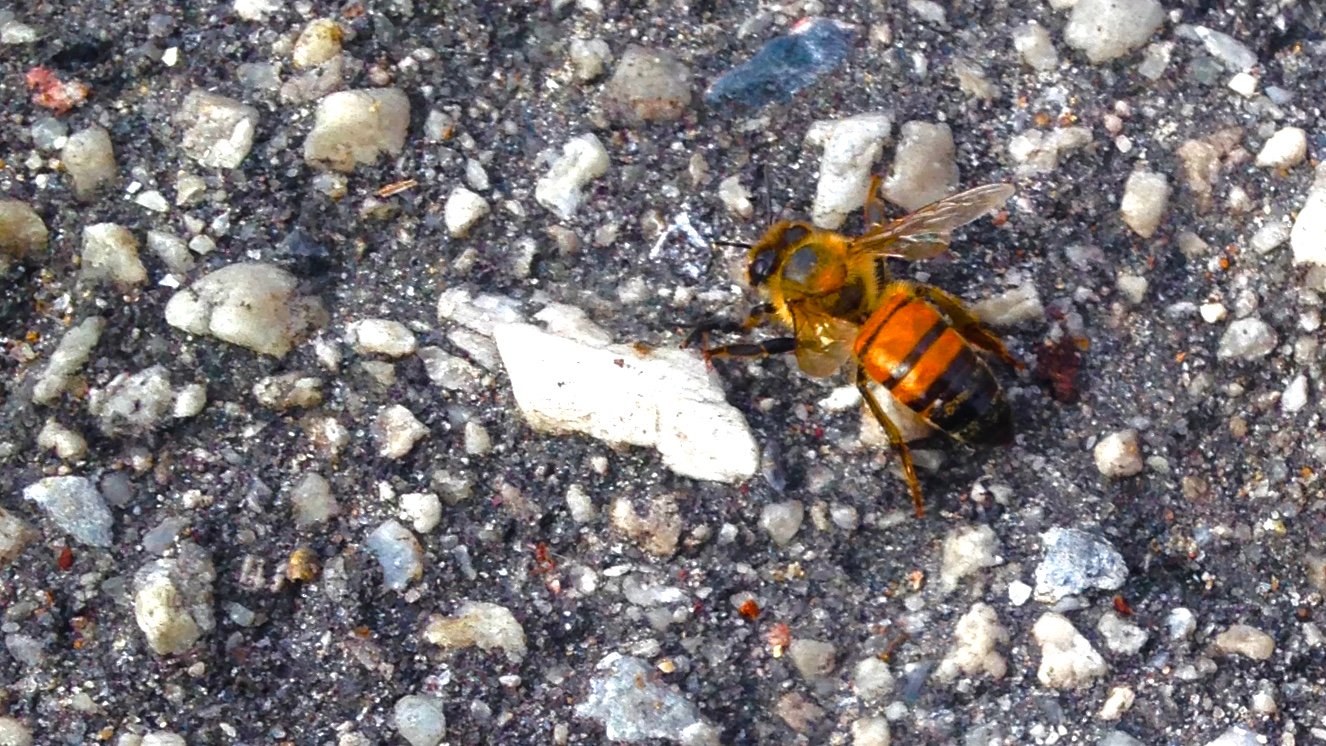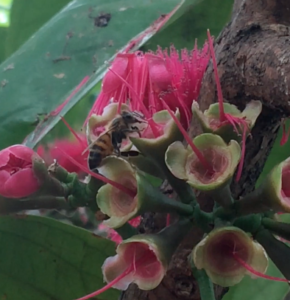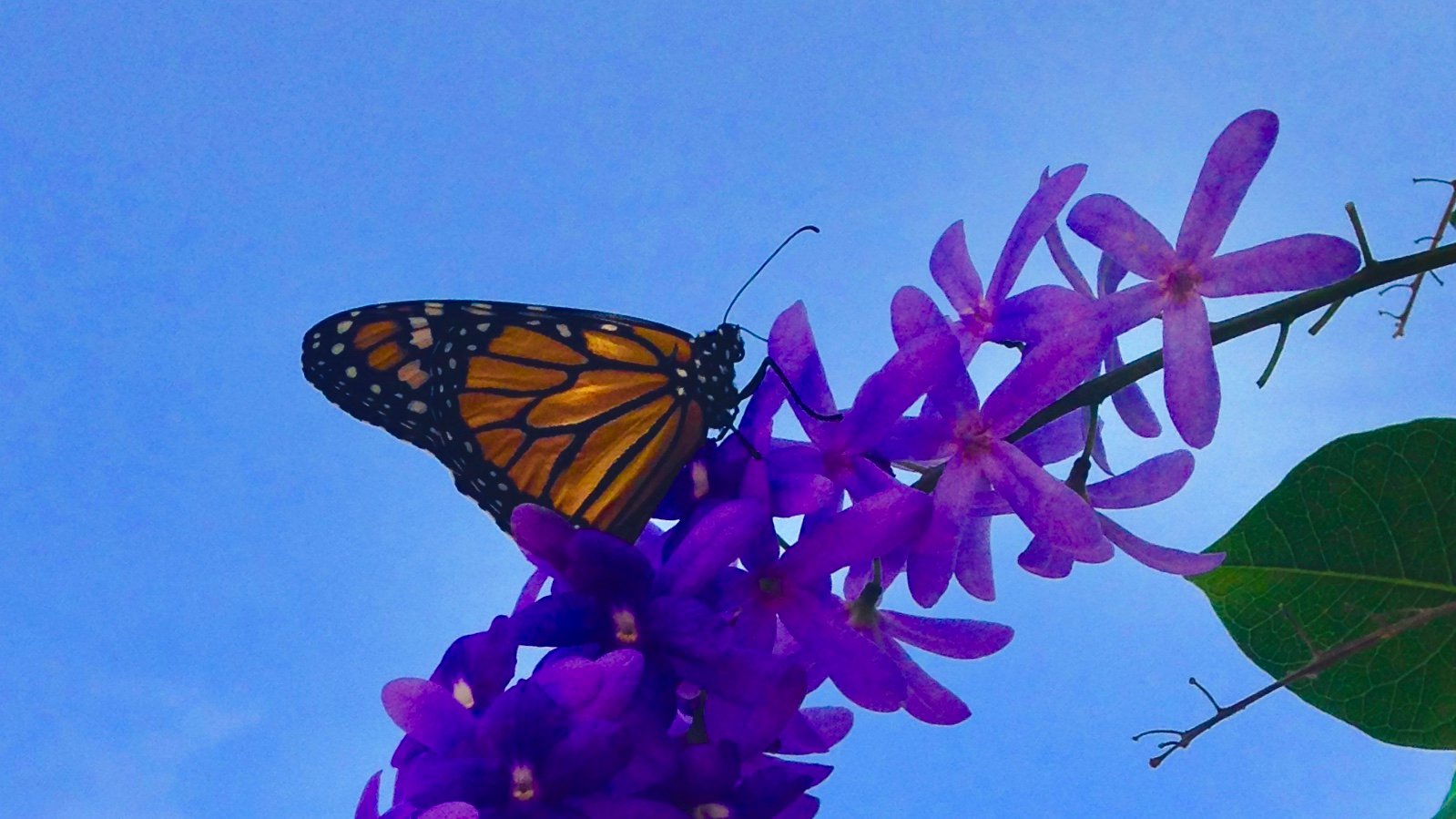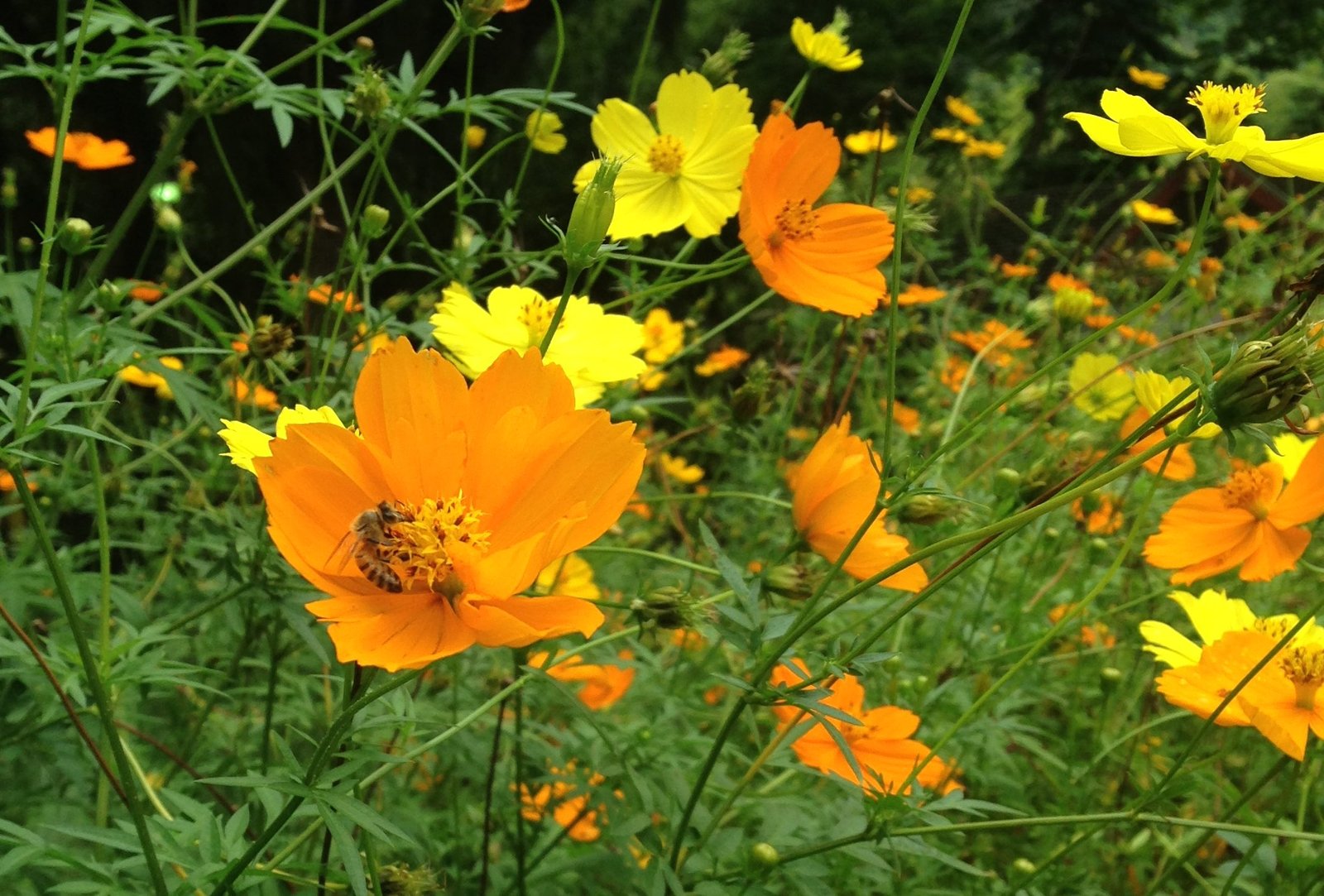We Just Don’t Know Enough

“The proper use of science is not to conquer nature but to live in it.”
~Barry Commoner
Continuing on my quest to learn more about the eco-system services bees provide, specifically pollination, I sought the knowledge from both a friend and former co-worker. Her name is Lena Dempewolf, and she is a PhD candidate at the University of the West Indies (UWI), St. Augustine. Her thesis: “Identification, Assessment, and Valuation of Pollination Services in Neotropical Agricultural Landscapes, Trinidad, W.I.” is in the final process of publication.
I met Lena for the first time in 2011, while pursuing my B.Sc. at UWI. During Semester II of my first year, she was my lab demonstrator for BIOL 1462- General Ecology and Biometry. I remember her having a no-nonsense approach to labs, while still maintaining a friendly disposition. Later, when I worked as a Teaching Assistant at UWI, for the department of Life Sciences between 2015-2017, she became a great colleague and friend.
In this post, Lena shared the findings from her thesis, and her recommendations about what can be done to improve our current environment using the eco-system services bees can potentially provide.
One of the important eco-system services bees provide is Pollination. We are all familiar with this, and most of us associate the words “bees” and “pollination” with the images of Honey bees, which belong to the Apis genus. However, these honey bees only represent a small fraction of the estimated 20,000 bee species that exist worldwide.
 Within the Apis genus, there are 11 true honey bee species of which only one is a hybrid known as the Africanised bee (See left photo). In Trinidad and Tobago, there is only 2 species of domesticated Apis, the European honey bee (Apis mellifera) which resides exclusively in Tobago, and in more recent times, the Africanized bees, which resides in Trinidad. In other parts of the world there are other Apis bees, such as Apis cerana and Apis dorsata in South east Asia.
Within the Apis genus, there are 11 true honey bee species of which only one is a hybrid known as the Africanised bee (See left photo). In Trinidad and Tobago, there is only 2 species of domesticated Apis, the European honey bee (Apis mellifera) which resides exclusively in Tobago, and in more recent times, the Africanized bees, which resides in Trinidad. In other parts of the world there are other Apis bees, such as Apis cerana and Apis dorsata in South east Asia.
According to Lena, “There’s a lot of research coming out that honey bees are not necessarily the ones that do a lot of the pollinating.”
Although they do contribute to pollination, they are not the ones doing all the work! In fact, research has shown that Honey bees (Apis bees) can do more damage than good by over-visiting plants. They can actually damage or even destroy flowers while in the process of collecting nectar and pollen. These bees are also outcompeting local bee species, also known as the wild or native pollinators, which are specialized for pollinating local plants.
In Trinidad and Tobago, and the wider Caribbean, this can be considered a big problem since these Apis bees are actually an invasive species brought from the Old World. They can fly on average, anywhere up to 10 kilometres to get their food. The local bee species tend to fly no more than 100 metres from their hive. Therefore, people using agricultural pesticides are likely to get rid of the local bees but not the invasive ones, since they have a longer flight range, and may live further away.
What contributes a lot to pollination, whether it be crop plants, wild plants, endemic species or otherwise, is the combined effort from all different bee species. It’s not just the work of any one particular bee species.
Sadly, many people are unaware of all these other types of bee species. As a matter of fact, there is a very small proportion of bees that are social; that live in hives, and produce honey. Otherwise, a large proportion are solitary; they don’t live in hives. Instead, they live in burrows in the ground, holes in the wood of tree trunks, don’t produce honey, and don’t even sting! These are the ones that are very specialized for pollinating the plant and flower species that occur in the various locations they live in, rather than the generalist feeder bees.
Many people are also under the impression that if all the Honey bees (Apis bees) were to die, human beings will no longer survive. However, this is a common misconception. Lena pointed out, that a shortage of honey bee pollinators does not necessarily mean a food shortage, since most food crops don’t depend on honey bees for pollination! It’s more of a “nutrition shortage” since there would be a reduced diversity of crops. She stated:
“There’s a lot more to pollination. You have fly species, a ton of wasps, moths and butterflies depending, not so much for crops, but there are other things they pollinate. There are other animals, such as lizards, lemurs and monkeys carrying pollen for trees.”
Did you know?
Even bats play a huge role in pollination. Imagine there are about 70 species of bats in Trinidad. [See here]
 So what makes a pollinator a pollinator?
So what makes a pollinator a pollinator?
Lena replied, “Depends on a million things. It has to visit a flower, not just that flower but several flowers of the same kind within a short time-frame, because of the amount of pollen that it carries. Pollen must be viable, the stigma must be receptive, and they [pollinators] must not damage the flowers as some make holes in the flowers when they collect nectar. Some even collect excess pollen, carry it back [home] and feed on it. There are a lot of factors… How much competition it gets from other species etc.”
She made the comparison:
It’s like someone getting up in the morning and deciding whether or not to eat breakfast. Many factors will influence this activity such as: need, distance to food, selection available, waiting period, etc. In a similar way, many factors influence the choices of pollinators.
Why did Lena choose this topic?
When I asked Lena what encouraged her to pursue this area of research, she exclaimed excitedly,
“I really needed something that moved! And I always liked insects.”
However, when she started searching for background information for her scope of study, she soon realised that it was not going to be an easy task.
“When I started, I realised there is not a SINGLE DROP OF DATA for the entire Caribbean available on pollination.”
With the exception of one or two research papers here and there,
“Nobody has ever sat down and looked at the pollination service as a whole in the Caribbean. So there is no data.”
Most data available for pollination is either for temperate countries, or the Old world tropics for places like Borneo. Personally, I would have been frustrated, and considered this an overwhelming task to undertake. I might not even have continued the study, but not Lena. After six and a quarter years of research, Lena shared a brief insight into the discoveries she made in her thesis:

Firstly, Lena established a Pollination network. This is where she tried to match insects with crop plants.
“We were literally running around catching all these insects, killed them, washed them off, then looked at the pollen grains to see if it matched up with any of the crop plants we collected them from; we got ideas of what species visit what kinds of flowers, and which crops they carry pollen for.”
Lena considered this information important because:
“We have no data and that’s terrifying, because we don’t even know what we have and what we’re losing. We could be losing things all the time and we don’t even know.”
Just last year, the Caribbean nation of Dominica was devastated by hurricane Maria. One will never know what Pollination network existed before the damage, and one never will, simply because there is no data. Lena added, “I think a bit of a saving grace right now is agriculture (in Trinidad & the Caribbean) is not as developed as other places. This is the one thing that keeps us from having a real problem, because we still have all these forest patches around.”
This is why her field of study is very important. In order to inform not only farmers, but the general public, the first step is to keep a physical account of the species we have now. This will ensure that we know what makes up the pollination service with the different crops we have now. From there we can identify, quantify and see how these species and their pollination services change over time.
In the second part of Lena’s pursuit of understanding pollination in the field, she explored fascinating questions such as: how distance to forest edge affects pollinators in farms, that is, whether or not they decline with distance, how weather affects them, whether the flowers planted in the middle or side of a bed affects pollination and the most intriguing question to me was if pollinators approached male or female flowers in cucumbers. An interesting observation made was some bee species went exclusively to male flowers in cucumbers, presumably to collect pollen, while none visited the female counterpart. This is a problem because you get a lot of visitation, but no pollination.
She also discovered that for Cucumbers, the smallest pollinators provide the full pollination amount. So, if we didn’t have any Apis bees, cucumbers would be just fine. She determined this by setting up enclosures with mesh pads. This prevented insects the size of true honey bees or larger from getting in to pollinate, but still allowed smaller insects in. She found that the native species of bees, due to their smaller size, were better adapted to pollinating smaller flowers such as cucumbers, as well as flowers that may otherwise be too fragile, such as avocados and mangos.
However, in other crops such as hot peppers, when pollinators were excluded using the mesh pad enclosures, 88% of hot peppers observed didn’t develop. The estimated loss per acre for hot peppers was $1000 USD per week, and $12,000-$13,000 USD per crop cycle. The information gathered from her thesis was used to assess total loss for farmers. That is: How much money would be lost per acre, per crop cycle, etc.?
Thirdly, Lena carried out a survey to determine how farmers interacted with the pollination service, such as—farmer knowledge about pollinators, their pesticide and herbicide use for specific pests, and whether or not they thought they had any influence or control over the pollinators were all assessed. Less than 40 % of the farmers showed a basic understanding of pollinators.
“A lot of them didn’t know, which was a little bit scary. A few did know, but they were in the minority.”
Most replied that they sprayed to kill everything. Pesticide application was quite a lot, and they didn’t really spray with any kind of pollinators in mind. In the survey, pollinators were ranked low, in terms of ecosystem services compared to water and nutrient cycling, etc. The farmers were also of the belief that they have no influence or control over the pollinators. Ultimately, the aim is not to ban pesticides completely, but instead use them more sensibly, and choose the ones with the lowest impact on pollinators.
Did you know?
The amaranth plant, more commonly known in Triniadad and Tobago as bhagi is used in our local indo-cuisine and is known to be largely wind pollinated. However, bees love this particular plant to the point where farmers have informed Lena that in order to get bees to go visit and pollinate the other crops such as cucumbers in their fields, they had to cut them down because the bees preferred going to wild amaranth plants.
So what can farmers do?
Although most farmers in Trinidad are small-holders; own 10 acres of land of less, they can influence, or control pollinators. Lena recommended these ways:
- Have a few stingless bee bee-hives interspersed between your crops. That way, you have your own pollination supply, and honey supply without worrying about being stung! Lena is a strong believer in sustainable stingless bee beekeeping and will be explored in a future post.
- Be careful about what you spray, and how you spray. Bees mostly visit in the morning period, usually between 9-10 am, because most stigma is receptive, and pollen viable early in the morning. Most species are active between 10-11am. If you must spray something, spray it around 6 pm, when the bees are all back at their hives.
- When spraying, cover the hives, or move the hives out of the way while you spray, then put them back about 3 days later. There’s a guy in Arima who doesn’t spray at all when his plants are flowering. So that’s an option too.
- Use pesticide/herbicide products that target specific pests.
- Don’t spray when flowers are open.
- Plant hedge rows to prevent wind drift from pesticide/herbicide use onto other crops.
- Leave unplanted patches of habitat in between crops as a refuge for insects.
Other Recommendations for the general public:
- Increase their awareness and education in differentiating the beneficial insects and which are pests. If people understand which insects are helpful, we may improve the way we do crop production by keeping them safe and provide habitat for them.
- Maintain regular monitoring, evaluation and integration of pollinators into the fields.
- Engage students at the Primary schools level. By having kids become interested in insects at an early age, they can learn respect for these creatures rather than cultivating a negative mind-set that the general public projects, such as insects are eww, or creepy crawly. Insects help make your food, maintain a nice forest for hiking, swimming and so on.
- Target a particular pest that is a problem using specific control methods for that organism rather than generic pesticides that target a broader range of insects to help manage their farms.

What happens next with this research?
Lena proposed the need for more baseline data from future researchers, even if it just involves the observation of insects in the Caribbean. In her search for one answer, numerous questions arose out of her study and many problems were identified. One of the major problems she brought to our attention was the need to develop proper keys for the Caribbean to identify bee species. If one really wants to develop the agricultural sector, particularly crop and honey production, these are some of the basic things one should look at to further improve production.
For example, when asked questions like how climate change affects pollination in the Caribbean, she made it clear that it’s difficult to determine the effects of climate change on pollination in the Caribbean, since there is no data yet. We do know that the main problem that temperate countries face would be the change in flowering seasons. If the flowering seasons occur earlier, then the activity of both the bees and flowering periods may miss each other. As a result, plants will not become pollinated since they bloom at a time when the bees are inactive. Another question that came out of her study in terms of pollen deposition was, how many pollen grains does it take to produce a fruit?
“We just don’t know enough.”
While some may see this as an issue, I see a new frontier for the younger generation with a wide scope for more research opportunities. A salute to people like Lena who choose to pioneer the way forward. There is hope. We hope this post helps to educate everyone, especially farmers with the information we have compiled here to assist them in improving their farming techniques. We hope that this will ultimately help you make decisions that will increase the productivity of crops you plant. We also hope to highlight to future researchers that there is a lot of things we don’t know about pollinators in Trinidad and Tobago and the Caribbean. This is a great opportunity for you to explore and discover new things in the field of food production, agriculture and environmental studies!
Photographer & Editor: A. Peter
Another fascinating, well written and enjoyable piece. I didn’t know about amaranth so thanks for that. Your friend is doing trailblazing work and I wish her success in her research endeavours.